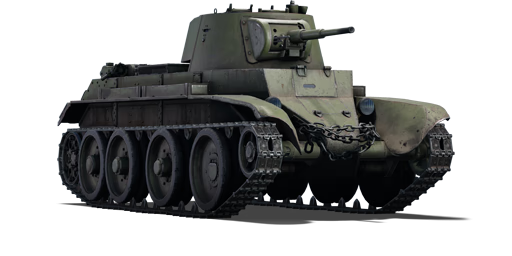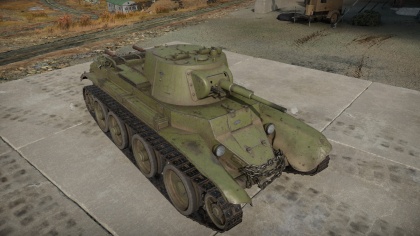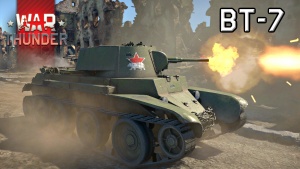Difference between revisions of "BT-7"
(→Legacy: Edits) |
m (→Pros and cons: Added "Great suspension for driving.") (Tag: Visual edit) |
||
| Line 206: | Line 206: | ||
* Good cannon with a good rate of fire | * Good cannon with a good rate of fire | ||
* APHEBC round packs enough punch to deal with every target you will face | * APHEBC round packs enough punch to deal with every target you will face | ||
| + | * Great suspensions for driving. | ||
'''Cons:''' | '''Cons:''' | ||
Revision as of 16:33, 5 June 2020
Contents
Description
The BT-7 mod. 1937 is a rank I Soviet light tank
with a battle rating of 1.3 (AB/RB/SB). It was introduced during the Closed Beta Test for Ground Forces before Update 1.41. Like the BT-5, but with improved front armour, it is fast and has an adequate 45 mm cannon able to destroy opposing tanks.
The BT-7 is a fast tank with relatively thin armour. It can be useful to flank and hit the side armour of enemy tanks, taking advantage of its very high top speed. The armour is very well angled at certain points, however being as thin as it is, don't count on it to protect you very well; your speed can be your best defence, so move fast and try to zig-zag a bit to make yourself a more difficult target for tanks farther away (not too much though, or you'll bleed off too much speed).
The BT-7 surprises with its Christie suspension. Closer to a race-car than a tank, this lightning on tracks is fun to drive, but not particularly easy. With its high top speed and lightweight, this tank will drift in turns. For maximum control in turns, reduce throttle beforehand and the only tip/nudge the turn-keys. It needs some time to get used to, however, it does prepare you for the T-34s break-turns.
Off-road behaviour is good and the aforementioned drifts aren't as extreme as on city-roads. Top speed is not really reduced as well, making the BT-7 one of the fastest early tanks due to its very wide tracks, something both the Light tank M2 and Panzer II miss.
The crew compartment is very small and only inhabited by the driver, commander and another crew member. The latter has to perform the tasks of the gunner and radio-man. "Not getting shot at" is the best advice for the crew to survive.
The BT-7 was the last of the BT series of Soviet cavalry tanks that were produced in large numbers between 1935 and 1940. They were lightly armoured, but reasonably well-armed for their time, and had much better mobility than other contemporary tank designs. The BT tanks were known by the nickname Betka from the acronym, or its diminutive, Betushka.
The BT-7 tank's successor would be the famous T-34 medium tank, introduced in 1940, which would replace all of the Soviet fast tanks, infantry tanks, and medium tanks then in service.
General info
Survivability and armour
With 20 mm armour on the front and with all that inclination on the armour panels, this vehicle had decent protection. With 5 mm less armour on the turret, that's the vulnerability of the tank, especially on the turret's backside, where the ammo is stored. However, you only get 3 crew members in the vehicle, making the tank vulnerable to any "crew knocked out" scenarios. One strong point for the vehicle is that you have speed, and the trade-off of speed vs. armour can come in handy especially travelling around 59 km/h (It's very hard to reach 60 km/h) ensures any enemy SPG will be very unlikely to hit close to you!
Armour type:
- Rolled homogeneous armour
| Armour | Front | Sides | Rear | Roof |
|---|---|---|---|---|
| Hull | 15 mm (62°) Front glacis 20 mm (19°) Driver's hatch 20 mm (5-52°) Lower hull |
20 mm Front 15 mm Rear |
10 mm (55°) Top 13 mm (16-58°) Bottom |
10 mm |
| Turret | 15 mm (7-53°) Gun mantlet 15 mm (13-14°) Turret front |
15 mm (13°) Front 13 mm (10°) Rear |
13 mm (15°) | 10 mm |
Notes
- Tracks and suspension wheel are both 15 mm thick.
Mobility
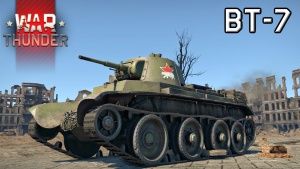
| Game Mode | Max Speed (km/h) | Weight (tons) | Engine power (horsepower) | Power-to-weight ratio (hp/ton) | |||
|---|---|---|---|---|---|---|---|
| Forward | Reverse | Stock | Upgraded | Stock | Upgraded | ||
| Arcade | 55 | 11 | 13.7 | 620 | 763 | 45.26 | 55.69 |
| Realistic | 50 | 10 | 354 | 400 | 25.84 | 29.2 | |
Like its predecessor the BT-5, the BT-7 has competitive mobility, easily being able to reach capture points before most other tanks or get to competitive camping spots before anyone else, the 400 hp engine gives the BT-7 29.2 hp per ton, which also allows the BT-7 to scale hills and smaller obstacles with relative ease.
Armaments
Main armament
The 20-K is the typical Soviet rank I gun. Players should get used to it since it will be your main armament up until rank II. The APHEBC round has a good amount of HE filler, meaning penetrating shells will do good damage, sometimes even one-shotting enemies. At much longer ranges, shells begin to lose penetration and accuracy but on most common low tier maps this is not a problem due to the smaller map sizes.
| 45 mm 20-K | Turret rotation speed (°/s) | Reloading rate (seconds) | |||||||||||
|---|---|---|---|---|---|---|---|---|---|---|---|---|---|
| Mode | Capacity | Vertical | Horizontal | Stabilizer | Stock | Upgraded | Full | Expert | Aced | Stock | Full | Expert | Aced |
| Arcade | 188 | -6°/+25° | ±180° | N/A | 15.23 | 21.08 | 25.60 | 28.31 | 30.12 | 3.77 | 3.33 | 3.07 | 2.90 |
| Realistic | 9.52 | 11.20 | 13.60 | 15.04 | 16.00 | ||||||||
Ammunition
| Penetration statistics | |||||||
|---|---|---|---|---|---|---|---|
| Ammunition | Type of warhead |
Penetration @ 0° Angle of Attack (mm) | |||||
| 10 m | 100 m | 500 m | 1,000 m | 1,500 m | 2,000 m | ||
| BR-240 | APHEBC | 70 | 68 | 59 | 50 | 42 | 35 |
| BR-240SP | AP | 73 | 71 | 62 | 52 | 44 | 37 |
| Shell details | |||||||||
|---|---|---|---|---|---|---|---|---|---|
| Ammunition | Type of warhead |
Velocity (m/s) |
Projectile Mass (kg) |
Fuse delay (m) |
Fuse sensitivity (mm) |
Explosive Mass (TNT equivalent) (g) |
Ricochet | ||
| 0% | 50% | 100% | |||||||
| BR-240 | APHEBC | 760 | 1.43 | 1.2 | 9.0 | 29.3 | 48° | 63° | 71° |
| BR-240SP | AP | 757 | 1.43 | N/A | N/A | N/A | 47° | 60° | 65° |
Ammo racks
| Full ammo |
1st rack empty |
2nd rack empty |
3rd rack empty |
4th rack empty |
5th rack empty |
6th rack empty |
7th rack empty |
8th rack empty |
9th rack empty |
10th rack empty |
11th rack empty |
12th rack empty |
13th rack empty |
Visual discrepancy |
|---|---|---|---|---|---|---|---|---|---|---|---|---|---|---|
| 188 | 174 (+14) | 162 (+24) | 147 (+41) | 135 (+53) | 123 (+65) | 108 (+80) | 89 (+99) | 73 (+115) | 57 (+131) | 41 (+147) | 25 (+163) | 13 (+175) | 1 (+187) | No |
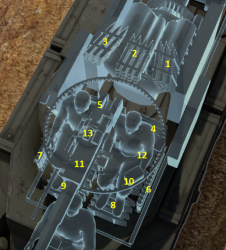
Turret empty: 147 (+41); Side racks empty: 89 (+99)
Machine guns
| 7.62 mm DT | ||||
|---|---|---|---|---|
| Mount | Capacity (Belt capacity) |
Rate of fire (shots/minute) |
Vertical guidance |
Horizontal guidance |
| Coaxial | 1,890 (63) | 600 | N/A | N/A |
Usage in battles
There are two common schools of thought when driving the BT-7, firstly rushing a capture point using your better than average mobility to get there before other friendly or enemy tanks, this tactic can help to gain points early in the game and perhaps even a few kills as enemy tanks try to take the point that you captured, but your fairly thin armour will leave you at risk of being crippled and destroyed by enemy fire unless you retreat to cover or get backup from friendly vehicles. A second school of thought it not charge right into the combat, but wait a while to see how the battle develops - observe where and how many enemy tanks go, maybe fire a few shots from a distance. Use your great mobility to get to the best positions and flank the enemy, from these positions you could snipe into the main battler area to damage and kill enemy vehicles you could then decide to use the BT-7's mobility to charge at lonely opponents, which at close range have no chance of keeping their guns pointed at you as you can essentially drive circles around them. Keep in mind that charging into more than 1 opponent is usually a quick end as it is very hard to not get hit from either of them at the same time. There is basically paper armour on BT-7 to stop anything other than machine gun fire, overall speed is key, being mobile and changing your position often will be a great way to avoid enemy fire and potential revenge kill attempts.
You should be aware of vehicles with high calibre machine guns and autocannons, in most cases you will have trouble stopping these as they will easily go through your armour, particular examples are German vehicles with the 20 mm KwK/FlaK38 cannon such as the Pz.II, Flakpanzer 38 and more, this gun might be small but can have up too 64mm of pen which is more that enough to cause lasting damage to the BT-7, luckily majority of these vehicles have fairly thin armour, so if you identify one near your location it would be wise to destroy them before they destroy you.
If you lose one of your 3 crew members it would be advisable to head to a friendly capture point to use your crew replenishment as your vehicle needs 2 members to operate, and having a 'spare' crew member can come in handy
Modules
| Tier | Mobility | Protection | Firepower | ||
|---|---|---|---|---|---|
| I | Tracks | Parts | Horizontal Drive | BR-240SP | |
| II | Suspension | Brake System | FPE | Adjustment of Fire | |
| III | Filters | Crew Replenishment | Elevation Mechanism | ||
| IV | Transmission | Engine | Artillery Support | ||
Pros and cons
Pros:
- Very fast and nimble
- Excellent offroad capability
- Powerful engine and wide tracks make the BT-7 a good climber
- Good cannon with a good rate of fire
- APHEBC round packs enough punch to deal with every target you will face
- Great suspensions for driving.
Cons:
- Exposed tracks and suspensions are prone to be damaged
- The whole tank is basically ammo rack and fuel tank on tracks
- Difficult to drive with precision - can slew on turns and bounces a lot after braking.
- Thin armour overall, making it easy for enemy vehicles to critically damage the BT-7
- Vulnerable to heavy machine gun fire
- Worse gun depression than earlier BT-5
History
Development
The success of the BT light tanks in Soviet service prompted additional upgrades and other developmental projects done on the design to increase its service life. The development led to the final model of the BT light tank series, the BT-7. The tank differed from the older BT-5 tank with a welded hull, redesigned hull front, and a new engine in the Model 1935 version. The Model 1937 version of the BT-7 added a redesigned turret that featured sloping armour.
The tank initially had a canted-ellipse shaped turret mounting the main gun and coaxial machine guns with the focus of allowing the tank to mount different tanks without changing the whole design, which led to the development of two main kinds of BT-7s, the normal variant with a 45 mm 20K gun for anti-armour and a artillery variant called the BT-7A which mounted a 76.2 mm KT-26 howitzer for anti-infantry. The tank was redesigned before it entered production by using the BT-5 turret instead with the main gun and coaxial machine gun still attached, though the concept of swapping to different guns was still in development for the tank. A radio was also installed on the turret as well. The tank had a three-man crew, the commander/gunner and loader in the turret, and the driver in the front. Production started in 1935 but was redesigned in 1937 with a new conical turret that allowed more ammunition to be stored and a machine gun on the rear of the turret. The BT-7 mod. 1937 also had improvements on the drive wheels, gearbox, and tracks by 1938. The BT-7 went on to be produced from 1935 to 1940 for a total unit production of between 2,700 to 5,300 tanks.
Combat usage
The BT-7 served alongside its older counterpart BT-5 tanks. The BT light tanks were meant to be a cavalry tank, and at the time of their introduction, they were considered some of the finest tanks against other countries' tanks. They had great mobility of all available tanks, and it's 45 mm gun could perform very well in combat. The only drawbacks of the design were its light armour and its gasoline engine, which caused the design to be rather flammable to improvised incendiary weapons. The BT-7's most notable combat service came against the Japanese at Khalkhin Gol. The tactics of Soviet Marshal Georgi Zhukov and the performance of his BT-5 and BT-7 tanks led to a decisive victory. It was during this battle that the BT tanks tendency to catch fire was found, but its performance was positive against the inferior Japanese armoured forces.
The BT-7 next combat use was during the opening stages of Operation Barbarossa when Nazi Germany invades the Soviet Union. The superior German tanks Panzer III and Panzer IV was able to easily take out these lightly armoured tanks. Reports note that about 2,000 BT-7 tanks were lost in the first 12 months alone against the German forces, with hundreds broken down from low maintenance and were abandoned. Despite their inferiority, the Soviets continued to produce and field them among armour and mechanized units to boost their operational capacity, though most were kept away from the front lines due to their inadequacy. The BT-7 would finally see its service again in Soviet invasion of Japanese-controlled Manchuria. The Soviets fielded the BT-7 and other tanks in its inventory against the inferior Japanese forces in Manchuria, where it proved very effective against the more lightly armoured Japanese tanks employed. The BT series were all retired after the end of World War II due to their obsolete design as an inter-war period tank design.
Legacy
Perhaps the most important impact the BT light tanks series was that it kick-started the development of the T-34 medium tank, which would go on as the most produced tank of World War II. A new design team was formed in 1937 at the KhPZ factory, where they built prototypes utilizing the more armour and a heavier gun onto the design, which was called the A-32 and was approved for production as the T-34 tank. The BT tanks also serve as the basis of support vehicles such as the BT-7A artillery tan, BT-7TU command tank, OP-7 flamethrower tank, and even the TT-BT-7 remote-controlled tank. An attempt in 1940 also had the BT-7 up-armoured with hinged homogeneous armour, which added five tons to the design weight. These vehicles are not known to have seen service in combat units.
| The BT-7 also holds the record for the furthest jump in a tank, at 42 metres, set in 1936. |
In-game description
In the second half of 1937, the BT-7 tank was mass-produced with a conical turret, a three-speed gearbox and strengthened suspension. In comparison to the BT-7 Mod. 1935, the tank's weaponry became more powerful due to the inclusion of a DT machine gun in the turret. Its ammunition capacity was increased by 44 and totalled 188 rounds in the battle vehicles and 145 rounds in the command vehicles equipped with a radio set. Some of the tanks were equipped with an anti-aircraft gun.
The unit command vehicles were equipped with a 71-TK-1 radio set with a hand-rail antenna, and later with a rod antenna. To allow the vehicle to fire its cannon and coaxial machine gun at night, it was equipped with two special projector headlights. Over the course of its modernisation, the thickness of its frontal hull armour reached 22 mm. The turret's armour was also strengthened using vertically sloping armour plates. Its combat-loaded weight grew to 13,925 kg. Factory No. 183 alone manufactured 4,727 tanks of this series.
The BT-7 underwent its trial by fire in the Khalkhyn Gol river region as part of the 6th and 11th tank brigades. In the process, the latter undertook a hurried 500 km trek to the scene of the conflict. On the whole, the tanks gained a good reputation, but their drawbacks were noted as well: they were difficult to drive, which meant they required highly trained drivers, and they had insufficient armour and poor communication equipment. All these flaws were confirmed in the Poland Campaign of September 1939 and in the Winter War with Finland.
With appropriate tactics and a well-trained crew, the BT-7 could successfully oppose all types of German tanks at the beginning of the war, being inferior to them only in armour.
BT-7 tanks participated in combat operations on the Soviet-German front right up until 1944, and in 1945 they served in the war with Japan. A few captured tanks served in the Finnish army until the beginning of the 50s.
Media
See also
Links to the articles on the War Thunder Wiki that you think will be useful for the reader, for example:
- reference to the series of the vehicles;
- links to approximate analogues of other nations and research trees.
External links
Paste links to sources and external resources, such as:
- topic on the official game forum;
- encyclopedia page on the tank;
- other literature.
| USSR light tanks | |
|---|---|
| T-26 | T-26 · T-26 (1st Gv.T.Br.) · T-26-4 · T-26E |
| BT | BT-5 · RBT-5 · BT-7 · BT-7 TD · BT-7M · BT-7A (F-32) |
| T-50 | T-126 · T-50 |
| T-70 | T-70 · T-80 |
| PT-76 | PT-76B · PT-76-57 · Object 906 |
| BMP | BMP-1 · BMP-2 · BMP-2M · BMP-3 |
| BMD | BMD-4 |
| 2S25 | 2S25 · 2S25M |
| Wheeled | BA-11 · BTR-80A |
| Other | T-60 · Object 685 · 2S38 |
| China | ▂Type 62 |


